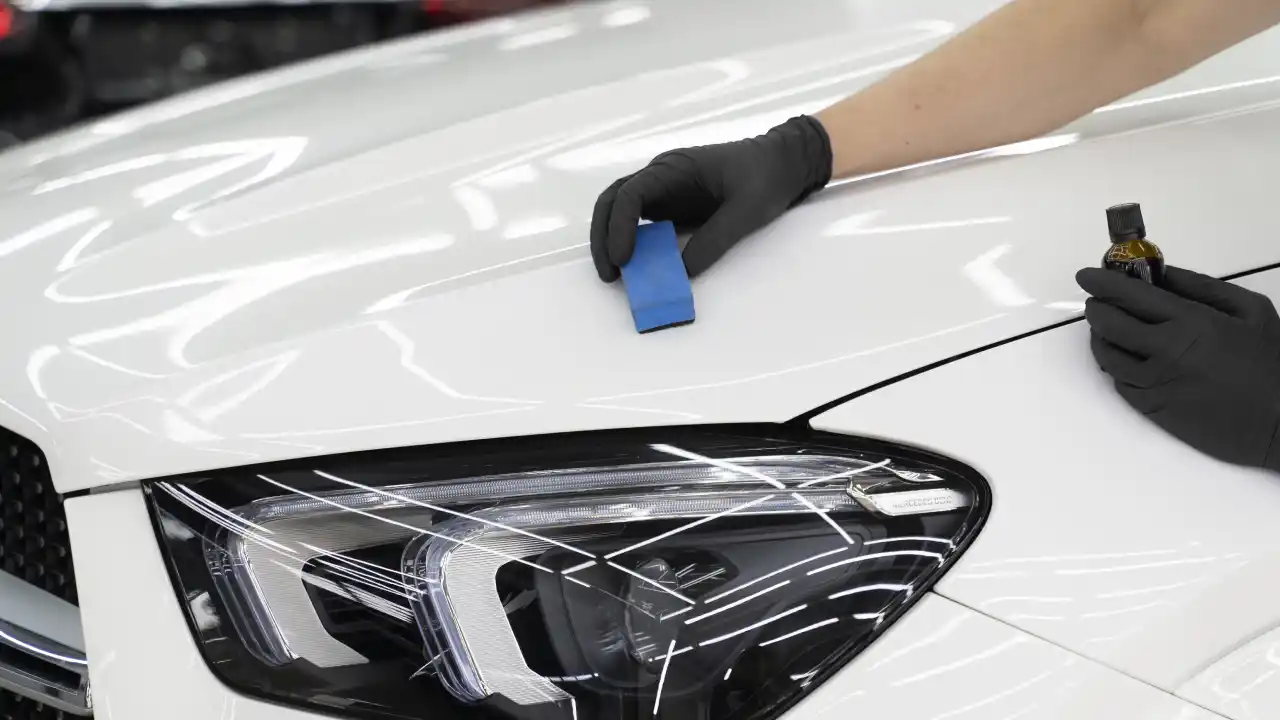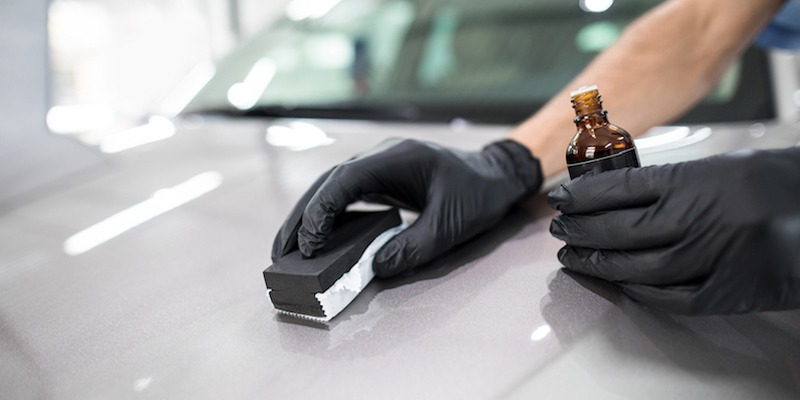The Duty of Ceramic Coating in Enhancing Your Cars and truck's Resale Value
The Duty of Ceramic Coating in Enhancing Your Cars and truck's Resale Value
Blog Article
The Importance of Ceramic Coating: Safeguarding Your Cars and truck's Outside With Precision
In an era where preserving the aesthetic and useful integrity of your automobile is critical, ceramic coating arises as an essential solution. With its distinct bonding residential properties, ceramic finish offers a level of defense that far goes beyond standard waxing approaches.
Benefits of Ceramic Coating
When it comes to preserving a vehicle's visual charm, ceramic finishing provides substantial advantages. By creating a semi-permanent bond with the car's paint, ceramic finishings efficiently avoid oxidation and fading, making sure that the automobile keeps a glossy, showroom-like coating for a prolonged duration.
Along with its protective qualities, ceramic coating offers remarkable hydrophobic residential properties, causing water and various other liquids to grain off easily. This feature simplifies the cleaning procedure, as dirt and debris are much less likely to comply with the surface, reducing the frequency and initiative required for upkeep. Moreover, the layer's resistance to chemical discolorations from acidic pollutants like bird droppings and tree sap is one more noteworthy benefit, reducing prospective paint damage.
Ceramic coatings likewise enhance scratch resistance, offering a layer that can take in small abrasions and swirl marks. This attribute is especially useful in keeping an excellent surface area, reducing the possibility of noticeable flaws and preserving the integrity of the automobile's paintwork gradually.

How Ceramic Layer Functions
Recognizing the mechanics behind ceramic layer exposes its effectiveness as a protective solution for cars. Ceramic coverings are basically fluid polymer applications that chemically bond with a vehicle's factory paint, developing a safety layer. This layer acts as a barrier against ecological pollutants such as crud, ultraviolet, and dust rays, which can deteriorate an automobile's outside with time. The essential component in ceramic finishing is silicon dioxide (SiO2), which stems from quartz crystals and is understood for its outstanding solidity and resilience.
Application of ceramic covering entails a precise procedure. The lorry's surface area must be thoroughly cleaned and sanitized to guarantee optimum bond. Once used, the liquid polymer creates a semi-permanent bond with the paint, hardening into a transparent, durable shield. This shield enhances the car's gloss and hydrophobic homes, assisting in less complicated cleansing by creating water and impurities to bead and slide off easily.
Moreover, the coating's molecular framework supplies resistance to minor scrapes and chemical stains. Unlike waxes or sealers that rest on top of the paint, ceramic finishings incorporate with the surface, using resilient protection. This integration is basic to its efficiency, ensuring the vehicle's finish continues to be immaculate for many years.
Contrasting Ceramic Coating to Alternatives
In the realm of vehicle protection, ceramic finishing stands as an awesome alternative when compared to standard options such as waxes and sealers. While waxes provide a temporary lustrous finish, typically lasting just a few weeks to months, ceramic coverings offer a longer-lasting remedy, frequently enduring for many years. This longevity is attributed to the chemical bonding that occurs when ceramic coatings are applied, creating a strong layer that is immune to ecological hazards.
Contrastingly, sealers, although even more durable than waxes, still disappoint the durable security provided by ceramic finishings. Sealers can usually last for as much as a year, offering an artificial guard versus particular components. Nonetheless, they lack the remarkable hydrophobic residential or commercial properties and UV defense that ceramic finishings supply.
In addition, ceramic layers use improved scratch resistance, which neither waxes nor sealants can efficiently match (ceramic coating). This is specifically valuable in preserving a car's immaculate appearance. Furthermore, ceramic coatings simplify upkeep efforts by reducing the adherence of dirt and gunk, consequently helping with less complicated cleaning. In summary, while conventional waxes and sealers offer standard security, ceramic finishes provide an extensive, long-lasting option that substantially preserves the vehicle and boosts's exterior surface.
Application Process Explained
Using ceramic covering to a vehicle requires a thorough process to ensure ideal outcomes and toughness. The preliminary action involves extensively cleansing Look At This the auto's surface to remove dust, grease, and previous waxes. This is vital for making sure the finishing adheres effectively. A pH-neutral shampoo and a clay bar therapy are commonly made use of to accomplish a beautiful surface area. As soon as cleansed, the automobile is dried out and polished to get rid of any kind of imperfections, as any kind of existing swirls or scrapes can come to be more noticable after the coating is used.
Following surface area prep work, the application of the ceramic finish starts. Utilizing an applicator pad, the ceramic finishing is used in little sections to make certain also look at here now coverage.
After application, the finish needs a specific healing duration, throughout which the automobile needs to be secured from water and impurities. This curing process can differ depending on the product yet generally varies from 24 to 2 days. Ultimately, this detailed process is critical in achieving a shiny and durable surface.
Maintenance Tips for Durability
To maintain the longevity of a ceramic finishing, adherence to a regimented upkeep regimen is crucial. Normal cleaning is extremely important; utilize a pH-neutral cars and truck shampoo and soft microfiber gloves to avoid abrasions. Prevent automatic automobile cleans, as their extreme brushes can jeopardize the finishing's integrity. Instead, go with a hand laundry to make sure detailed yet gentle cleaning.
Post-wash, drying out the lorry with a clean microfiber towel prevents water spots that might weaken the finishing gradually. Additionally, apply a ceramic finishing booster every few months. These boosters reinforce the hydrophobic residential properties and improve the finishing's safety capabilities, ensuring it stays reliable against pollutants.
Remember that vehicle parking locations play a vital function in maintenance. ceramic coating. Whenever feasible, park in shaded areas to minimize UV exposure, which can progressively deteriorate the layer. For long-lasting storage, consider utilizing an automobile cover for included defense versus environmental aspects
Final Thought
In verdict, ceramic coating offers as an essential protective layer for car outsides, offering durable protection versus environmental aspects such as grime, dirt, and uv rays. Recognizing the application process and adhering to maintenance referrals are important for making best use of the longevity and efficiency of ceramic layer.
When it comes to protecting a vehicle's aesthetic allure, ceramic finishing supplies substantial advantages. By creating a semi-permanent bond with the automobile's paint, ceramic layers efficiently avoid oxidation and fading, ensuring that the vehicle keeps a shiny, showroom-like surface for an extensive period. Ceramic coverings are basically liquid polymer applications that chemically bond with an automobile's factory paint, producing a protective layer. In summary, while typical waxes and sealants provide standard defense, ceramic coatings offer a comprehensive, long-lasting option Visit This Link that dramatically maintains the car and enhances's exterior coating.

Report this page